Eyelid / Mid-face lift (Eye Bags)
Baggy eyes can result from slackening of the muscle beneath the skin allowing the fat, which cushions the eyes in their sockets, to protrude forward giving the appearance of bagginess, puffiness or tired-looking eyes. The excess skin of the upper eyelid can hang over the eyelashes and may even interfere with vision.
Baggy or tired-looking eyes can be inherent (manifesting in the 20s) or be a consequence of the ageing process. The sagginess, droopiness and bagginess can be worse in some people than others due to hereditary factors, excessive sun exposure or smoking.
Upper and/ or lower eyelid surgery is a common procedure that results in a fresher and more youthful looking face.
The upper and lower eyelids can be operated on at the same time or on separate occasions.
What is Eyelid Reduction (Blepharoplasty)?
Eyelid reduction (blepharoplasty) is a procedure to remove excess skin, possibly muscle and usually fat from the upper and or lower eyelids.
The Surgery
The upper eyelids as such can be operated on under a local anaesthetic (while awake) or under a general anaesthetic (while asleep). In a typical operation, the scar follows the natural lines of your eyelids. This is usually done as a day case.
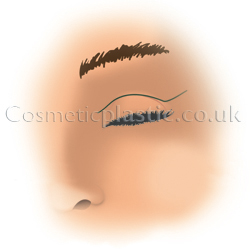
Upper Eyelid Surgery
If only lower eyelids or both the upper and lower eyelids are operated on, a general anaesthesia is advisable. For the lower eyelids, the scar is just below the eyelashes. It can extend into the crow's feet or laughter lines at the outer corners of the eyes. This usually involves 1 night stay.
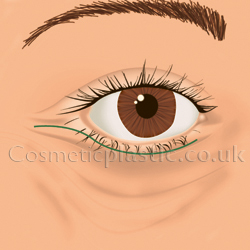
Lower Eyelid Surgery + Midface Lift
|
Before
|
After
|
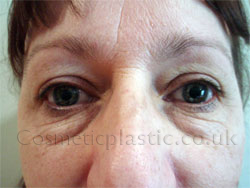
|
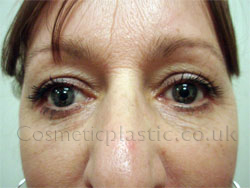
|
Upper and Lower Eyelid Surgey + Midface Lift
|
Before
|
After
|
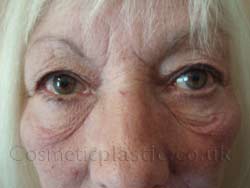
|

|
Eyelid surgery will not remove crow's feet or other wrinkles nor eliminate dark circles under the eyes, or lift sagging eyebrows. These are best dealt with by non-surgical procedures. Eyelid surgery can be combined with other cosmetic surgery procedures. There is very limited improvement to the folds of skin extending on to the cheek (festoons).
Recovery
Following surgery it would be best to keep your head elevated for a few days to reduce swelling. Cold compresses can also help. There will be adhesive plaster to support the stitches which are usually removed a week or so after the surgery.
The extent and duration of bruising can vary from one patient to another. It is generally advisable to avoid strenuous exercises for a period of 6 weeks after surgery.
The eyes can be watery after surgery, partly because of swelling under the conjunctiva and partly because the tear ducts are swollen and do not drain as readily. The scars will eventually become almost invisible.
Potential Risks
Every surgical procedure carries a certain amount of risk, and it is important that you understand the risks involved with eyelid surgery.
Swelling and bruising are very common after this surgery. Asymmetry, slight dryness or watering of the eye and conjunctivitis can occur. With lower eyelid surgery there are the risks of increased pigmentation, residual bags, hollow eyelid and retracted (pulled away from the eye) lower eyelid. Loss of sight is an exceptionally rare but significant risk.
Bleeding, infection, wound break down, excessive scarring, blood clots in leg veins and/or lung and further revisional surgery are general risks that can follow any operation.
The information provided gives you a basic understanding of the eyelid surgery but it may not answer all your questions, a lot depends on your individual circumstances.This website provides guidance and is not intended to be a substitute for a surgical consultation with Mr Fahmy in Shropshire, Chester, Cheshire or Wrexham, North Wales and Mid Wales.
For any enquiries, you can email Professor Fahmy on info@cosmeticplastic.co.uk. Your consultation will be directly with Professor Fahmy and the treatment will be performed by himself at the hospital of your choice either Pulford Medical Centre Chester (Cheshire) or Spire Yale Hospital, Abergele & Wrexham (Wales). It is always advisable to bring a friend or a relative during your consultation, as it may further assist you in any questions you may have.
Notice of Copyright ©: 01 July 2008 - The documents and images on this website have been created by Prof. F Fahmy (author), who reserves all rights to their use for purpose of publication, sale, commercial gain, or promotion. Permission must be sought to download, reproduce, copy, print, or otherwise transform any of the documents or images on this website. The copyright for all pictures remains with Prof. F Fahmy.